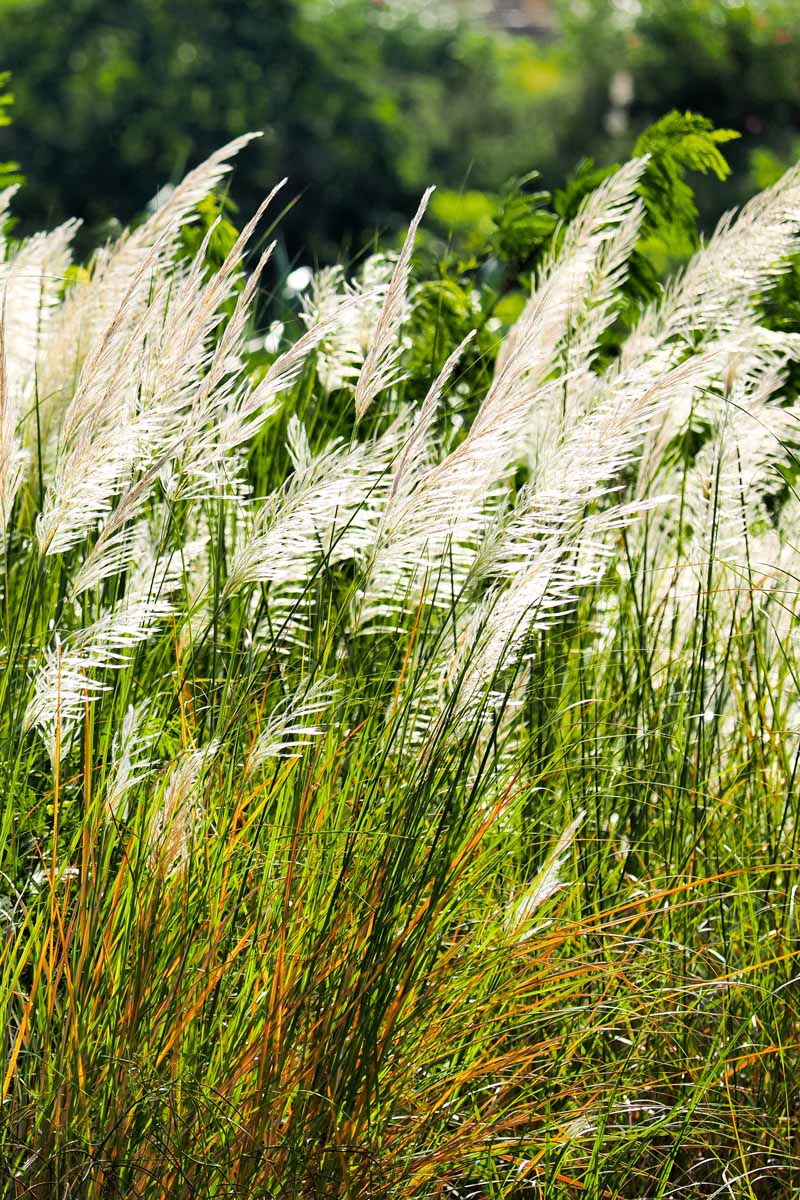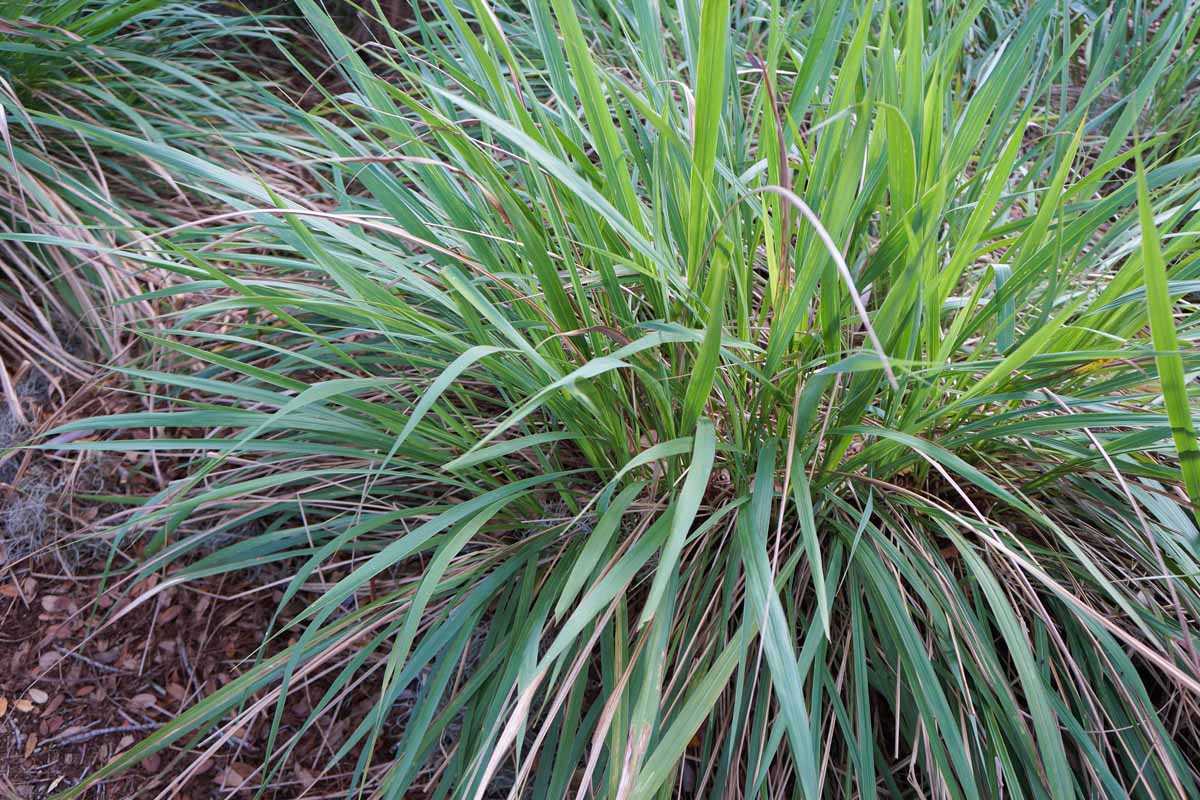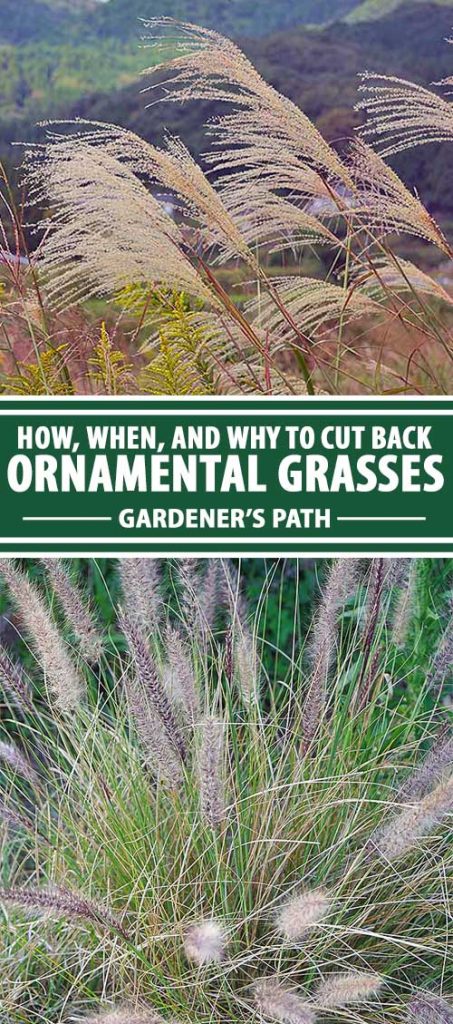Ornamental grasses are increasingly being used in our landscapes as an alternative to shrubs.
In any region of the country, you can find native grasses that do quite well, and add textural variety and a soft, flowing aspect to the garden.
These plants are particularly attractive when grown in groups. Examples include any of the many Miscanthus varieties, blue fescue (Festuca glauca), and Mexican feather grass (Nassella tenuissima).
A few are evergreen in the southernmost parts of the United States.

We link to vendors to help you find relevant products. If you buy from one of our links, we may earn a commission.
But most are deciduous, rewarding gardeners year after year with fresh blades in solid or variegated green, red, and coppery colors, as well as prolific and attractive plumes and seed heads.
And while largely maintenance-free, many of these plants do benefit from an annual haircut. Let’s learn more about how to trim them up for maximum growth and beauty.
Enjoy Them Throughout Winter
While you likely won’t do any irreparable harm if you trim ornamentals back in the fall, we recommend you wait until late winter or early spring before you bring out the shears.
Many of these plants – especially those with spent plumes and attractive seed heads – offer alluring winter interest, particularly if snow or ice graces their foliage.

Keeping the leaves around also protects the crown of the plant throughout the winter, but you do want to prune the old growth before the new growth begins.
Leaving the dead material on too long can impair the crown’s warming and delay new growth by as long as three weeks.
If you delay the haircut until after new shoots have appeared, you’ll want to trim the old material carefully.
If you cut the new blades, they’ll have a raggedy, unnatural appearance all season.
Here in Austin, we prune our big grasses back in late January. Floridians can start chopping in early January, while our northern friends may have to wait until later in spring.
How Low Should You Go?
Start with a very sharp pair of hedge clippers, such as these from Fiskars, available via Amazon.
The 10-inch blades on these clippers will help you to get through any clump of grass quickly. Be sure to sharpen your blades frequently, as the grass will dull them.
Some gardeners use a hedge trimmer or even a chainsaw on older and tougher grass clumps.
Next, put on a long-sleeved shirt as the blades of grass can be quite sharp!

Fiskars Power Lever Hedge Shears
Tightly tie twine, rope, or a bungee cord around the clump, about two feet up from ground level, and cut below the tie.
This makes it easier to access the clump as you cut it, and it also provides you with a neat, tidy bundle to carry away and dispose of.
How short you cut these plants depends on whether they are cool-season or warm-season grasses.
While the cool-season varieties grow best when temperatures are 60 to 70°F, the warm-season grasses like it hot, and prefer temperatures in the 80 to 95°F range.
Warm-season grasses that are taller than three feet should be cut back to four to six inches from ground level. Shorter mature plants can be cut back to about three inches.
Prune cool-season grasses back by two-thirds.
The Greens Get a Rake
Some ornamentals, such as Fakahatchee grass (Tripsacum dactyloides), are evergreen in some parts of the country.
For these types, just rake through them a couple times a season with gloved hands to draw out any dead material.

If an evergreen grass grows to be too large, you can cut it back every couple of years. And of course, clip out the occasional dead blade as you encounter it.
Low Maintenance and Attractive
Elegant and flowy, ornamental grasses make a visually appealing addition to modern landscapes.
Cut them back as winter wanes and you’ll be rewarded with fresh and bright blades in springtime, and attractive plumes of seed heads in late summer and fall.

Do you have any of these types of plants in your landscape? When do you cut them back? Tell us about it in the comments section below.
And to learn more about growing ornamental grasses in your garden, check out these guides next:

Hallelujah ! Great advice. Here in SoCal we see huge clumps of ornamental grasses cut back in fall and looking like giant mounds. They never seem to recover. Well done!
I’m so glad you enjoyed the article!
Hi, I have 4 Black Stockings Dark Fountain Grass plants. I’m in Florida and planted them in May. They are doing so well and got so tall that some of the stalks are falling over. Can I trim them back now since have gotten so tall?
Hi Sandy…. thanks for reading. As I understand it, ornamental grasses can fall over from insufficient sun or from too much nitrogen. And yes, you can cut them back down if they’re an eyesore.
Hi,
I am wanting to plant some tall grasses (3 to 4ft) along the edges of my driveway. I don’t have room for ones that get large in diameter. Are there some that stay about 8″ in diameter? Or can you tell me how to keep them in small clusters? We have some in other areas of our yard but they have grown to be about 18″ in diameter, to big to put in the area. What can you advise me? We live in the northern part of Utah with hot summers and cold winters.
Hi Jerry… the trouble, as you’ve undoubtedly figured out, is that ornamental grasses tend tend to develop quite large clumps, bigger than what you have room for. I do wonder, however, if northern sea oats would work for you. This plant doesn’t clump so much as other ornamental grasses. It is a voracious spreader, but it doesn’t clump. It’s hardy to zone 4, and it can take brutal summers.
I live in Connecticut and am in a new house. Our ornamental grasses are starting to drape over the driveway which will be dangerous and annoying come
Snowfall. However it’s now below freezing most nights here. Can I still trim these grasses (maybe just the part that encroaches the driveway?) without damaging them?
Thanks,
Green Thumb Wannabe
Hi Courtney; congratulations on your new home — very exciting! Yes, it will be ok to trim your ornamental grasses now. Leave them as long as you can without impacting the driveway, though, to protect the crown. Then trim them again in early spring.
Love your simple info about grasses! I write a column, Consider the Garden, for a paper here in Santa Rosa California. It’s just about time to cut the grass is back my front yard is kind of wild with grasses and my backyard is more formal English. People that don’t Garden don’t understand what gardening is to us, right!? To watch a fern frond unfurl is pure Magic and now it’s going to be raining for days which is wonderful and much-needed. Thanks
Thanks for getting in touch, Kimberly! I was able to check out some of the back issues of the Upbeat Times online and I loved your January 2019 column, “The Quiet Garden.” Enjoying the much-needed rain immensely here in Los Angeles as well. 🙂
Perhaps you’d like to check out my piece on enjoying World Naked Gardening Day with all of the five senses, if you haven’t read it already.
Hi Kimberly! You’re close to my hometown, Eureka! I completely agree — non-gardeners don’t get it. I had to admonish a visiting neighbor as he was stomping all over some emerging plants. He probably thought they were weeds or something, but to me, they were precious!
Hi! Thanks for the info! I live in sunny Los Angeles and wanted to plant Miscanthus Morning Light in my front yard (Front and Center). Do I need to trim it back 4-6” in the winter/spring even being in So Cal? I worry that if this is the case, I may not be able to have them front and center as I had planned since they will look so bad after being trimmed back. Thanks for any help or guidance you can offer!
Hey Natalia! If you want the Miscanthus to bloom you should cut it back in the winter. Miscanthus is considered a cool season grass, and it puts on most of its growth in the early spring so that it’s at its best by late spring or early summer. If the grass isn’t trimmed it will grow wild and lopsided, and if it blooms the display will be lackluster. I’m not a big fan of cut back perennial grasses either, but if you hack it back to a height of 5-7 inches, you could then carefully trim the ragged ends so… Read more »
Hi Gretchen, love your articles! I live in PA and have ornament grasses that are large but some have dead centers. Is early spring a good time to divide them after trimming and what’s the best way to dig them up? Also, always struggle trimming my oak leaf hydrangeas. One year they have tons is flowers and once they had none. I need help. Thanks so much!
Hello Sam Earthman, thanks for reading! The main idea on dividing ornamental grass is to complete the task while they’re growing, but before they begin to flower. So early spring should do the trick. If you’re working with cool season grasses, you could also divide in early fall. I find it works best to dig up the whole clump and then pull it into a few pieces, each with its own roots. If the parent plant is not too large, I just use gloved hands. If you have to resort to shears, a sharp shovel, or a blade, remember to… Read more »
My neighbor wants to cut back his grasses as they are too out of control looking. He wants to cut them back from 48″ to 24″ even though it’s only June here in the Northeast and they still haven’t achieved full height. I told him this will look awful and he should get a different variety rather than cut back what he has. What to do?
Great column! Hope you can help me with some weeping lovegrass. The seedheads look really wonderful until they dry out and turn yellow, and they I tend to cut them back so the grass blades are more prominent. But cutting them individually (>50 per plant on an 80+ foot bank) can take forever! Do you have any techniques that would be faster? I cut the entire plant back in early Spring but like to maintain the plants during the winter as they look really great and still dance with the wind. Would appreciate your thoughts.